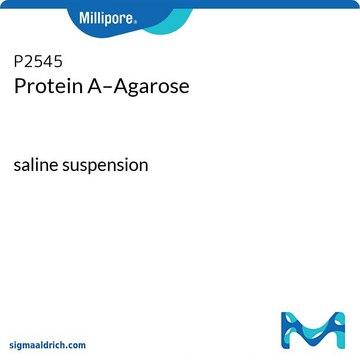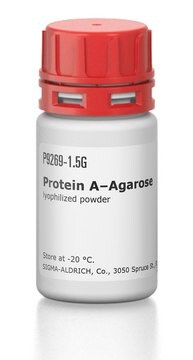P1406
Protein A–Agarose
lyophilized powder
Synonym(s):
Protein A resin
Sign Into View Organizational & Contract Pricing
All Photos(5)
About This Item
Recommended Products
form
lyophilized powder
Quality Level
extent of labeling
~2 mg per mL
matrix
Cross-linked 4% beaded agarose
matrix activation
cyanogen bromide
matrix attachment
amino
matrix spacer
1 atom
capacity
≥15 mg/mL binding capacity (human IgG)
storage temp.
−20°C
Looking for similar products? Visit Product Comparison Guide
Application
Protein A-agarose is used for affinity chromatography, antibody purification and characterization, and protein A, G and L resins. Protein A-agarose has been used to study the effects of protein A immunoadsorption in patients with chronic dilated cardiomyopathy as well as to study multiple sclerosis and gastric cancer. Protein A–Agarose has been used as an immobilized biosensor. It has also been used for immunoprecipitation.
Quantity
Swelling: 1 g swells to 3-6 ml
Physical form
Supplied as lyophilized powder stabilized with lactose.
Signal Word
Danger
Hazard Statements
Precautionary Statements
Hazard Classifications
Eye Dam. 1 - Skin Corr. 1B - STOT SE 3
Target Organs
Respiratory system
Storage Class Code
8A - Combustible corrosive hazardous materials
WGK
WGK 3
Flash Point(F)
Not applicable
Flash Point(C)
Not applicable
Personal Protective Equipment
dust mask type N95 (US), Eyeshields, Gloves
Choose from one of the most recent versions:
Already Own This Product?
Find documentation for the products that you have recently purchased in the Document Library.
Customers Also Viewed
Fredrik Fagerström-Billai et al.
Molecular and cellular biology, 25(2), 716-727 (2005-01-06)
Gene duplication is considered an important evolutionary mechanism. Unlike many characterized species, the fission yeast Schizosaccharomyces pombe contains two paralogous genes, tup11+ and tup12+, that encode transcriptional corepressors similar to the well-characterized budding yeast Tup1 protein. Previous reports have suggested
Z Chen et al.
Circulation research, 82(3), 367-374 (1998-03-05)
Phospholemman (PLM) is a small (72-amino acid) transmembrane protein found in cardiac sarcolemma that is a major substrate for several protein kinases in vivo. Detailed structural data for PLM is lacking, but several studies have described an ion conductance that
V A Lightner et al.
The Journal of cell biology, 108(6), 2483-2493 (1989-06-01)
Tenascin/hexabrachion is a large glycoprotein of the extracellular matrix. Previous reports have demonstrated that tenascin is associated with epithelial-mesenchymal interfaces during embryogenesis and is prominent in the matrix of many tumors. However, the distribution of tenascin is more restricted in
An integrated solution for rapid biosensing with robust linker free covalent bindingsurfaces
Yin Y, et al.
A Risk-Management Strategy for PCB-Contaminated Sediments (2013)
L G Reddy et al.
The Journal of biological chemistry, 270(16), 9390-9397 (1995-04-21)
Phospholamban (PLB) is a small, transmembrane protein that resides in the cardiac sarcoplasmic reticulum (SR) and regulates the activity of Ca(2+)-ATPase in response to beta-adrenergic stimulation. We have used the baculovirus expression system in Sf21 cells to express milligram quantities
Our team of scientists has experience in all areas of research including Life Science, Material Science, Chemical Synthesis, Chromatography, Analytical and many others.
Contact Technical Service












